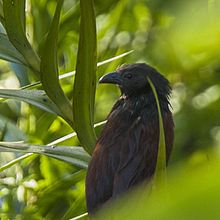Philippine coucal
| Philippine coucal | |
|---|---|

| |
| Scientific classification | |
| Domain: | Eukaryota |
| Kingdom: | Animalia |
| Phylum: | Chordata |
| Class: | Aves |
| Order: | Cuculiformes |
| Family: | Cuculidae |
| Genus: | Centropus |
| Species: | C. viridis
|
| Binomial name | |
| Centropus viridis (Scopoli, 1786)
| |
The Philippine coucal (Centropus viridis) is a species of cuckoo in the family Cuculidae. It is endemic to the Philippines. It is an insectivore.[2]
Description and taxonomy
[edit]EBird describes the bird as "A large, long-tailed bird of open or disturbed areas from the lowlands to middle elevations in the mountains. Entirely black except for rufous wings. A black-winged race from Mindoro occurs, as does an uncommon white form on Luzon. Forages for insects and other animal prey, on or close to the ground. Similar to Black-hooded Coucal, but has a black rather than brown belly and is found in more open habitats. Much larger than Lesser Coucal. Voice includes a slightly descending series of repeated “wok!” notes and a short, explosive “jek-wok-wok!”[3]
Subspecies
[edit]Four subspecies are recognized:
- C. v. viridis — Found on Luzon, Polillo, Catanduanes, Marinduque, Masbate, Panay, Negros, Cebu, Bohol, Samar, Leyte, Mindanao and Basilan
- C. v. mindorensis — Found on Mindoro, Semirara, Caluya and Sibay
- C. v. carpenteri — Found on Batan Islands
- C. v. major — Found on Babuyan
Medium, sexes similar; races differ in color carpenteri and mindorensis are all black while viridis and majer are black with chestnut wings, and in size carpenteri and majer are larger than viridis and mindorensis. in viridis [4]
Habitat and conservation status
[edit]Its natural habitats are tall grassland, secondary forest and thickets up to 2,000 meters above sea level
The IUCN Red List has assessed this bird as least-concern species as it has a wide range is able to tolerate a wide range of habitat where it actually benefits from human altered habitat. [4][5]
References
[edit]- A Guide to the birds of the philippines(2000) Robert S. Kennedy pedro C. Gonzales, Edward C, Dickinson Hector C. Miranda, jr. & Timothy H. Fisher
- ^ BirdLife International (2016). "Centropus viridis". IUCN Red List of Threatened Species. 2016: e.T22684240A93020846. doi:10.2305/IUCN.UK.2016-3.RLTS.T22684240A93020846.en. Retrieved 12 November 2021.
- ^ Serrano, Jocelyn; Guerrero, Jonathan; Quimpo, Josiah; Andes, Giovani; Bañares, Erwin; General, Mheljor (2019-08-07). "Avifauna Survey within a University Campus and Adjacent Forest Fragment in Bicol, Eastern Philippines". Applied Environmental Research: 84–95. doi:10.35762/aer.2019.41.2.8. ISSN 2287-075X.
- ^ "Philippine Coucal - eBird". ebird.org. Retrieved 2024-09-08.
- ^ a b Payne, Robert B. (2020). "Philippine Coucal (Centropus viridis), version 1.0". Birds of the World. doi:10.2173/bow.phicou1.01species_shared.bow.project_name. ISSN 2771-3105.
- ^ IUCN (2016-10-01). Centropus viridis: BirdLife International: The IUCN Red List of Threatened Species 2016: e.T22684240A93020846 (Report). International Union for Conservation of Nature. doi:10.2305/iucn.uk.2016-3.rlts.t22684240a93020846.en.

